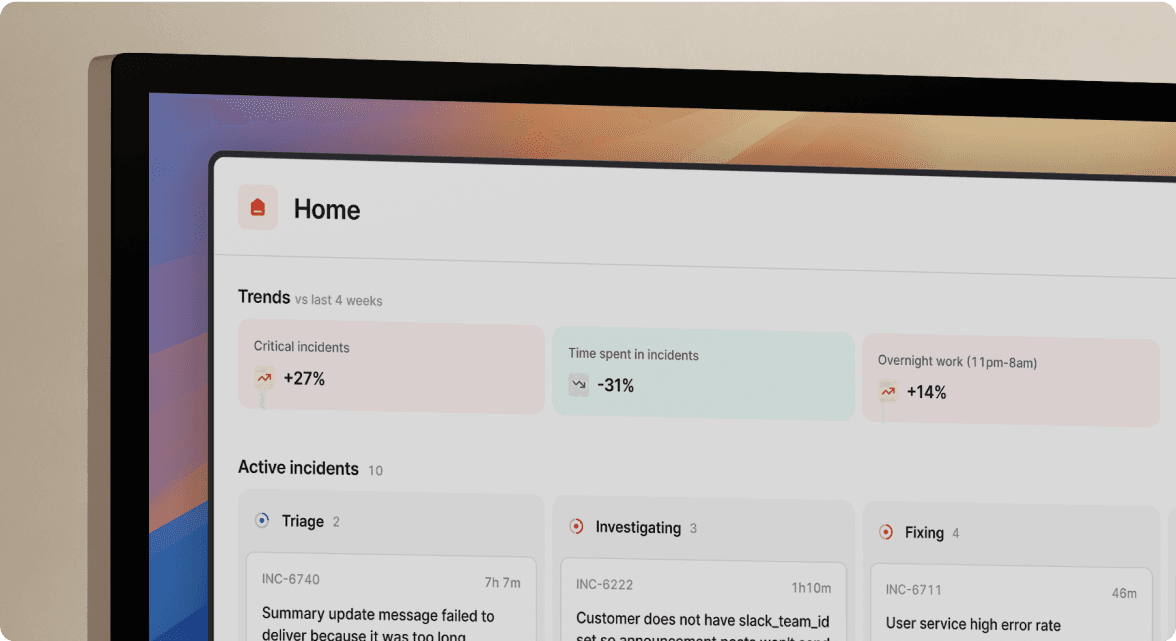Escalate to the next level
May 20, 2025

Occasionally, you are paged and brought into an incident that you can’t fully handle on your own. In these cases you might want to page another engineer to help you out.

For our Slack users, we’ve added a button that allows you to quickly escalate to the next level on your escalation path. This feature will show up once you’ve acknowledged an escalation in an incident channel, asking if you’d like to escalate further. You’ll then be prompted with a view of who you’ll page and what notification message we will send before notifying!
Prompt for cover after a bad night on the pager

If you've been paged a couple times overnight, you know the next day can feel rough and being on-call the next night might not be a good idea.
If you end up getting paged two times or more overnight, and you are on-call the following evening, we’ll send you a message in Slack in the morning to ask if you’d like to request cover. We’ll pre-fill the cover request modal so you can ask your team for coverage, allowing for a more restful night.
What else we've shipped
New
- You can now filter your alerts by deduplication keys
- You can configure the teams filter to show all incidents where your team members are active participants
- Set timestamps in email notifications to a user's local timezone when known
- Images pasted into Microsoft Teams channel will now appear in the timeline editor
- You can now import Opsgenie schedules that include teams as targets
Improvements
- The create API key modal has been given a glow-up and the scopes for each permission are also displayed
- We'll now show the full names of escalation path targets on hover in the escalation path editor
- When a call link is shared in a Slack thread, we ask about setting the call link directly in the thread instead of the main channel
- The icon in the demo data badge is now the correct size
- Apply styling to status page preview to better represent the real status page
- Improve conditions styling on policy requirements page
- We now use your user's timezone across the whole /inc cover modal, and fallback to the schedule timezone otherwise
- You can now use dynamic attributes in incident alert source resources in Terraform
- We now notify you in Slack if auto creating a call fails due to Zoom rate limits
- Improved the flow of updating an incident call URL to make Slack messages less confusing
- Added explicit support for removing incident calls via Slack
Bug fixes
- We fixed a bug where changes to custom incident names in your template weren't saving in alert routes
- Changes to a schedule's shifts made by an override will now automatically sync to Linear triage, rather than on the next schedule update
- Fixed an issue where you couldn't navigate home after opening the mobile app from a push notification
- Fixed a bug where Slack users weren't always synced immediately upon installing our app
- Layout of incident Kanban page is no longer broken for views with long filters
- We fixed setting expressions for SLA configuration in policies
- Don't suggest Slack features to Microsoft Teams customers when creating workflows
- Show 404 error message to user when incident form can't be found
- Fixed an issue where in the "by severity" table in Insights, MTTX would be occasionally incorrect
- Ensured the post-incident flow can no longer mark an incident as closed twice
- We no longer allow you to open the edit modal of a deleted announcement rule
- We no longer allow setting up custom field filtering on backlink attributes, as we don't actually support this
So good, you’ll break things on purpose
Ready for modern incident management? Book a call with one of our experts today.

We’d love to talk to you about
- All-in-one incident management
- Our unmatched speed of deployment
- Why we’re loved by users and easily adopted
- How we work for the whole organization



